Surrounded by enemy positions, with many wounded at risk, a small group of glider troops overcame the odds.

Glider: Waco CG-4A number 88, ‘Powder River Montana’, serial no. 245697.
Glider carrying: part of 11 Platoon of B Company, 1st Battalion of the Border Regiment, 1st Air Landing Brigade (1ALB).
Troops’ objective: Capture the outskirts of Syracuse.
Manifest
1 sjt
8 men
2 men R Coy
1 sig, Bn HQ
1 handcart
L Sjt F Terry
Cpl Coates
Cpl John ‘Pongo’ Waring, Bn Signal Cpl
L Cpl Morgan?
Pte John Raymond Davison
Pte Lathan
Pte Jones
Pte Miller
Tug Pilot’s Report
Tug: C-53, serial 42-47381, 51 Troop Carrier Squadron, 64 Troop Carrier Group, 51 Troop Carrier Wing USAAF.
Takeoff: Between 19:05 and 19:22, 9 July 1943, from Airstrip D, Goubrine Base, Tunisia, as part of Operation Labroke. Priority 12.
Tugs returned: Between 00:38 and 04:15, 10 July 1943.
Pilot: 2nd Lt Dennis E McClendon
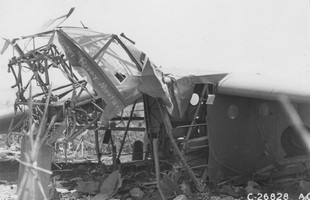
The pilots of 62 TCG must have submitted individual reports at debriefing, but if these were recorded, the document does not seem to have survived. However McClendon’s story appears in the book “The Glider War” by James Mrazek (1975).
McClendon’s plane, like all the other tugs towing Waco gliders that night, was one in a group of four, called an ‘element’. He described how the element was flying echeloned left at 200 feet when it came under AA fire from an Allied merchantman a few miles south of Cape Passero. McClendon vividly describes the scene being brightly lit by star shells, so presumably there can be no mistake as to who was firing. The ship was part of the vast fleet approaching Sicily to start the seaborne invasion landings at dawn. Five miles later it happened again. On each occasion the element leader (towing glider 85) took evasive action, turning into the path of the other three tugs, and risking spinning into the sea. In the second case he turned so abruptly he caused the formation to dissolve. McClendon then identified landmark after landmark on the route north, finally signalling the glider to release in the right place. He says was 40 minutes late, but there is no explanation as to why.
McClendon’s report is highly unusual. No Operation Ladbroke aircraft were shot down by friendly fire that night, and hardly any reported being fired on by ships at all, let alone twice.
Glider Pilot’s Report
Glider allotted Landing Zone: LZ 2.
First Glider Pilot: Sgt Kenneth ‘Taff’ Evans
Second Glider Pilot: Sgt Richard ‘Dick’ Martin
“Statement by Passenger. Flight uneventful but bumpy – glider hit telegraph wires on landing and crashed into wall 2 miles S. of CAPE MURRO DI PORCO. 3 wounded”
This short record in 1ALB’s report is by a passenger because both glider pilots were in hospital. Its errors cast doubt on the whole debriefing process. Seven men were wounded, not three, and the glider landed 2.5 miles WNW of the Cape, not 2 miles south of it, which would have put the glider in the sea.
In fact Glider 88 was one of the most accurate landings of the night [satellite] [view].
80 gliders were supposed to land in LZ 2. Aerial photographs show not one landed fully in the LZ (although burned gliders do not show up). Two gliders ended up straddling the boundary, partly in LZ 2, partly out. One of these two was glider 88. Its front ended up in a tomato field after smashing through a stone wall, leaving the tip of its tail outside the LZ.
A later inspection revealed:
“Forward part of floor crushed in, wings washed forwards. Indication of very high speed landing. No indication of fatalities.”
Glider pilot Taff Evans wrote an account for the August 1998 issue of ‘The Eagle’, the magazine of the Glider Pilot Regiment Association. As usual with eye-witness testimony, especially many years later, it disagrees in detail from McClendon’s account. But there are also signal differences. Evans makes no mention of star shells, or of being fired on by ships. He does recall his tug pilot making a violent turn at one point, flying into the rest of the formation, weaving right and left. Appalled, the glider pilots struggled to follow without breaking the towing cable. Evans reported: “I had impressions of other aircraft flashing past us in the blackness and not very far away either!”
Later, after releasing at 1900 feet over the sea, Gilder 88 was coned by two searchlights from the Maddalena Peninsula, and came under accurate light AA fire (presumably from the Italian coastal battery ‘Lamba Doria’ on the cape). Evans describes taking violent evasive action, diving repeatedly and even doing a stall turn. The latter in particular seems exaggerated, as it would have entailed the glider (loaded with men and a hand cart) in effect standing vertically on its tail, momentarily motionless in the sky, a sitting duck target. Plus all the manoeuvering would have used too much precious height. Releasing at 1900 feet, two miles out and gliding into the 35 mph headwind left scant margin for error. Perhaps Evans was being tongue-in-cheek, knowing that his audience was other glider pilots.
Evans managed to dodge the searchlights, but blinded by the brightness, he could not see properly when suddenly there was a crash and he was knocked out. Glider 88 had narrowly missed the top of low cliffs, then ploughed through power lines and a stone wall.
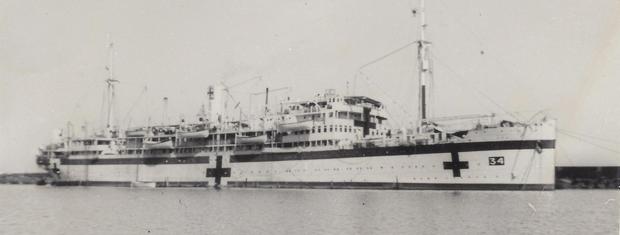
Evans broke his foot and his co-pilot broke his thigh bone. They and other wounded men lay in the glider for a day and a half, during which time they were intermittently under fire and even strafed by a German fighter plane. Eventually they were taken to hospital in Syracuse, then transferred to the hospital ship ‘Aba’, which took them to hospital in Tripoli in Libya.
The Action
The senior NCO in glider 88, L Sgt Terry, wrote a report shortly after the operation, which follows in full. Text in square brackets is editorial.
“On approaching the enemy coast, the tug and glider (No.88), in which we were travelling came under fire from the enemy ground defences. We took evasive action, breaking formation, and splitting up from the rest of the flight. We then released about two miles off shore, and crashed on the island about two hundred yards inland. [No mention here of violent evasive manoeuvres after release]. The glider hit telephone wires, and then crashed into a wall. This was at approx. two miles south of Cap Murro di Porco.
On landing we suffered the following casualties. Both glider pilots (broken legs), Pte Lathan (broken leg), Pte [Ray] Davison (body sprained or fractured leg), Cpl Coates (Head and leg injuries) Ptes Jones & Miller (lacerations of the head), remainder sustained bruises, cuts and shock.
The first thing we did, that is, those who were not badly injured, was to grab our weapons and the bren gun, and take up a defensive position round the glider, owing to the fact that we were subjected to fire from enemy ground forces immediately we landed.
Enemy fire ceased, and after checking our position, those who were able to do so moved off to try and locate the original landing zone, leaving one man behind to protect casualties. We travelled about half a mile North east and came across another crashed glider and a mortar det of the S Staffords who were in posn in a ditch about two hundred yds with their mortars and handcarts.
We joined forces and L cpl Morgan, a sjt, and a pte of the S Staffords went out on patrol for 30 mins to try and contact the remainder of our tps. On return they reported having met none of our tps, but enemy patrols. We were uncertain of our posn, and that of the Bn, so we decided to return to our glider, treat our casualties and try and contact any British tps in the vicinity. We sent out patrols throughout the night and made our casualties as comfortable as we could. We were unable to remove them from the wreckage because of the risk of complicating their injuries. We retrieved all serviceable arms and amn, but could not remove the handcart or its contents because of its damaged state and danger of falling on the injured. When this was completed, and our patrols had returned we took up defensive posns round the glider covering the beach with our gun.
When it became light we saw another glider [Waco 125A] which had crashed about 150 yds from us on our right. This glider belonged to the Bn Mortar Pl. With it were the following. One glider pilot offr [Lt Carn] with both ankles broken who was lying in the middle of the field, one glider pilot sjt [Sgt Richards] with both legs broken, Cpl Allen, and a Pte who had head and arm injuries. We attended to them, joined forces under command of the offr. He told us to take up a defensive posn around the area of both gliders.
Shortly after this enemy tps were seen approaching our posn from the beach. We engaged them, and they immediately retired to a blockhouse on the beach. L Cpl Morgan and Cpl Waring recced the blockhouse, and owing to our strength (six fit men) and the numerous wire defences around the blockhouse, no available cover to use, we decided to contain them with fire.
We were subjected to fire from MGs, from another blockhouse about a thousand yards to our left front, our front being the beach.
About this time a party of S Staffords (l sjt and 4 men) joined up with us, retrieved the 3” Mortar and bombs, and set it up in the vicinity of a house on our right, and proceeded to mortar the enemy posns.
We then came under heavy fire again by enemy tps on our right flank, and to the rear. We decided to use smoke (77 grenades) to cover our move to another posn, as we were well marked, and could not return fire effectively. The first grenade failed to go off, but the second one succeeded in setting fire to the stubble field in front.
This fire spread rapidly, and the offr who was injured was in danger of being caught in it. Cpl Waring went out, under fire, and managed to get the offr clear, and to the house. Also assisted by a Pte succeeded in evacuating the sjt pilot to the same place before their glider caught fire. This fire was instrumental in disturbing the enemy on the beaches by its rapid approach to them.
We were then joined by another party. They were as follows – two glider pilots, one medical orderly and five RE, some of whom had no arms or equipment as they had been captured by the enemy and later rescued by the comrades they were with.
The medical orderly proceeded to our glider to attend to our casualties. We were again subjected to fire from snipers who had taken up positions round us. As shots were hitting the glider, and our casualties were in danger of being shot, the medical orderly placed a white flag above the glider and turned the glider into a dressing station because it was impossible to move the casualties, and at this time we had been subjected to a MG attack twice from a flight of three enemy planes.
We then decided to turn the house near us into a first aid post for the medical orderly, and defend it till dark, when we could move. The medical orderly’s conduct during this period was first class, and all the injured were attended to by him.
At about seventeen hundred hours, owing to the mortar fire from our det, the enemy fire practically ceased, except for mortar fire which was very inaccurate and coming from forces inland.
Two men, Ptes Davison 12, and Brook of B Coy joined us after having swum ashore, and seeing us in our posn.
Enemy fire had now ceased altogether, and they were waving white flags. This was at about 1600 hrs. We took them prisoner (five of them).
After a talk with the injured offr [Carn] we decided to move towards Ladbroke [Syracuse], the offr saying he would be responsible for the injured and prisoners, and also the walking wounded who were to guard them. The following men were left behind for this purpose. Ptes Miller, Jones 14, Bennett and Davison [12] and Brook who were unable to go with us owing to the fact that they had no boots.
We then formed three secs, the S Staffords under their Sjt, one sec or Border under myself, L sjt Terry, and another party of RE and glider pilots under L cpl Morgan, and made our way towards Waterloo [the Ponte Grande bridge]. We contacted our own tps at an ADMS under Lt Tate of D Coy, and came under his command, reporting our landing posn and casualties in that area. In these actions our casualties were nil.”
Military Medal
Cpl Waring was awarded the Military Medal for his actions. His citation shows that he was considered for the superior DCM, but the demotion to an MM was initialled by General Montgomery, the commanding officer of the 8th Army in Sicily. The citation reads:

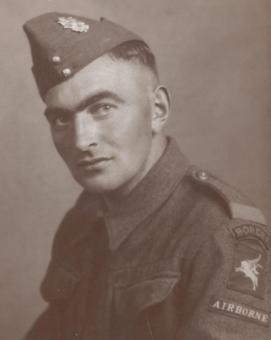
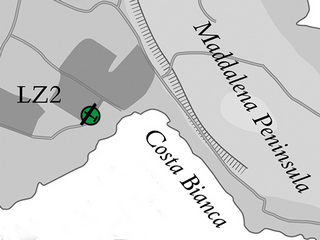
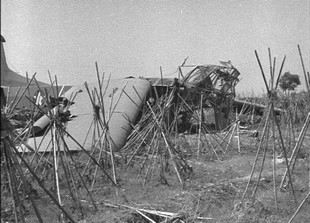
What an incredible read and with so much research. From being a young girl, my Grandfather (Pte J R Davison) would talk to me about the tomato field where they crash landed. He talked of the way that the gliders were dropped into the sea and all over the place. He and others, were incredibly lucky to have survived and to have been with such amazing courageous people. It is just wonderful to have more background to his stories. I can not thank you enough Ian, for helping me learn about Op Ladbroke, and the histories of the Border Regiment.
Thanks Faye!
A fantastic bite of information, thank you.
I’ve been conducting a little research and have got the following info from the CWGC and Mike Peter’s book about Chalk 125A. L Sgt Terry’s account of GP injuries differ slightly to Lt Carns, the fog of war and time I guess, but both accounts suggest Sgt DR is alive and being treated in someway. Is there any information on how Sgt DR died? I aim to visit his grave, along with all the other GP in Sicily, this summer.
III. G. 10. 2093467 SERJEANT DAVID WILLIAM JOHN RICHARDS. Died 12 July 1943. Son of David William and Ethel Annie Richards, of Barry, Glamorgan.
Operation Ladbroke. Chalk No 125A WACO. Departed from Airfield F Goubrine No 2. No 1 pilot was Lt W J Carn. Load – Mortar Pn 1 Border.
Made landfall an hit a low stonewall, both pilots broke their ankles on landing. Bunny Carn Broke both legs and Richards had a green stick fracture to his left leg. Lt W J Carn.
Love the website!
Thanks Matthew. There are accounts by Carn in the Army Flying Museum. He describes the wounded being taken to hospital in Syracuse, where there were amputations, and also deaths from gangrene (in the days before penicillin). He says Richards died of his wounds. Carn was later evacuated on board the hospital ship Amra.
I am the niece of DWJ Richards. He was known as Billy to his family, never David. I visited his grave October 2024. His family wernt given the information that he had broken his legs. They were advised that his glider had been blown into the cliffs on the night of 9th July. They wernt advised how/why he survived until 12th or cause of death.
Thanks Diane
This is an excellent read. My father was in 1st Batt Border Regiment in Operation Ladbroke. Sadly he’s passed but I think he said they landed quite a way from Pont Grande. I was hoping to see him mentioned ( Andrew McCann Scott) Are there reports from all the gliders that made landfall ? Any info greatly appreciated.
The only record of a Scott I can find was a private in R Company who was attached to C Company for Ladbroke. No initials are given, so perhaps it was some other Scott. There are no named manifests for 1 Border. The only C Company Waco listed as having R men in it and that reached land was 93. The only report for 93 states: “Glider just cleared the cliff & hit a wall. Crew surrounded by Italians after few minutes. 2 pilots killed, 6 wounded.” Border load lists can be found in Eastman’s “When Dragons Flew”, and short reports appear in Peters’ “Glider Pilots in Sicily”.